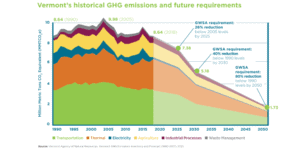Plan presents opportunities to spur economy, reduce energy use and costs
Achieving Vermont’s climate commitments is not only possible—it is also an opportunity to make energy less expensive for Vermont households and businesses while creating jobs for Vermonters. That’s one of the key findings of the latest Annual Progress Report for Vermont, released Tuesday, May 25, by the non-profit Energy Action Network (EAN).
“To meet our responsibility and seize this opportunity, we have to recognize that fossil fuels are our number one problem — both in terms of climate pollution and in terms of energy costs,” said Jared Duval, executive director of EAN. “To have a chance to meet our emissions reduction requirements under the Global Warming Solutions Act (GWSA)and to protect Vermonters in a time of social and economic disparities, we have to stop purchasing and installing new fossil fueled equipment when there are more affordable electric and renewable alternatives.”
The report also finds that Vermont’s dependence on 100% imported fossil fuel creates a major drain on the state economy—an average outflow of nearly $1.5 billion a year. In contrast, transitioning to more efficient transportation and heating solutions that use Vermont’s low-carbon electricity or renewable fuels can keep three to four times more money recirculating in-state. Moreover, because the cost of fossil fuels has historically been higher and more price volatile than electric and renewable alternatives, solutions like electric vehicles, heat pumps, and advanced wood heating have a triple benefit—pollution reduction, cost savings, and local economic investment.
“We can do this! The solutions can save Vermonters money while helping revitalize Vermont’s economy,” Duval said.
The report also summarizes EAN’s Emissions Reduction Pathways Model, which analyzes sector-specific pathways and actions that can add up to achieving Vermont’s climate commitments for 2025 and 2030. As of the latest data, Vermont is halfway to achieving its first greenhouse gas emissions reduction requirement of 26% below 2005 levels by 2025, with 2018 emissions 13% below those of 2005. However, Vermont is only at the starting line for the requirement to be 40% below 1990 emissions by 2030. As of 2018, emissions were just back to being equal with 1990 levels.
Over 90% of the decline in Vermont’s greenhouse gas emissions between 2015 and 2018 resulted from changes to the statewide electricity portfolio, mandated by the Renewable Energy Standard. However, the report also points out that no comparable policy or regulatory framework is yet in place to require pollution reduction from the transportation or thermal sectors.
“Vermont policymakers need to get serious fast about the transportation and thermal sectors, in particular,” said Duval. “Otherwise the numbers just don’t add up.”
Transportation and thermal sector fossil fuel use are together responsible for 74% of Vermont’s climate pollution.
Transportation
One of the most effective actions is the purchase and use of electric vehicles instead of fossil fuel vehicles. EAN models 46,000 EVs replacing gas vehicles by 2025 and 120,000 EVs by 2030. That would mean about one out of every four new vehicles purchased in Vermont over the next five years being electric and then at least one out of every two vehicles between 2026-2030. EVs can achieve rapid and significant pollution reduction, both because they use energy more efficiently than fossil fuel vehicles and because they rely on Vermont’s cleanest-in-the-nation electricity portfolio. EVs also have the benefit of saving rural Vermont drivers an average of $1,500 a year on fuel and maintenance compared to fossil fuel vehicles and are often less-expensive up-front, after incentives.
Heating
On the heating side, a variety of options can replace fossil fuel systems like propane and fuel oil, ranging from heat pumps to B100 biodiesel to advanced wood heat (including both efficient pellet stoves and automated wood heat boilers and furnaces). EAN also models a five-fold increase in home weatherization likely being necessary over the next decade, both to provide direct emissions reduction and cost savings from reduced fuel use and to open up additional opportunities to use clean heating systems. EAN’s report identifies an opportunity to weatherize 120,000 more homes by 2030, especially those of lower- and middle-income Vermonters.
To ensure that all Vermonters can access pollution-reducing, money-saving alternatives, the report emphasizes that policies and incentives need to be equitably designed, prioritizing lower-income Vermonters for assistance, in particular.
“As a legislator working on climate change, I am keenly aware that to do good work, we must have good data. EAN’s Annual Progress Report for Vermont provides essential, concise, non-partisan scientific information and analysis,” said Senator Christopher Bray, chair of the Senate Natural Resources and Energy Committee. “This report will be a very useful tool as we prepare our climate bills for next session.”
The report also comes as the Vermont Climate Council is working to develop a climate action plan for Vermont. Due in December, 2021 the plan will include recommendations about how to meet Vermont’s legally mandated emissions reduction requirements by 2025 and 2030.
“EAN’s Annual Progress Report for Vermont builds on the emissions inventory the Agency compiles annually, transforming this technical dataset into something far more accessible to Vermonters,” said Agency of Natural Resources Secretary Julie Moore. “This report, along with EAN’s Emissions Reduction Pathways Model, are invaluable resources in helping the public understand the magnitude of the work required to achieve the emissions reduction requirements established by the Global Warming Solutions Act.”
To read the full report, visit: eanvt.org/2021-EAN-report.





